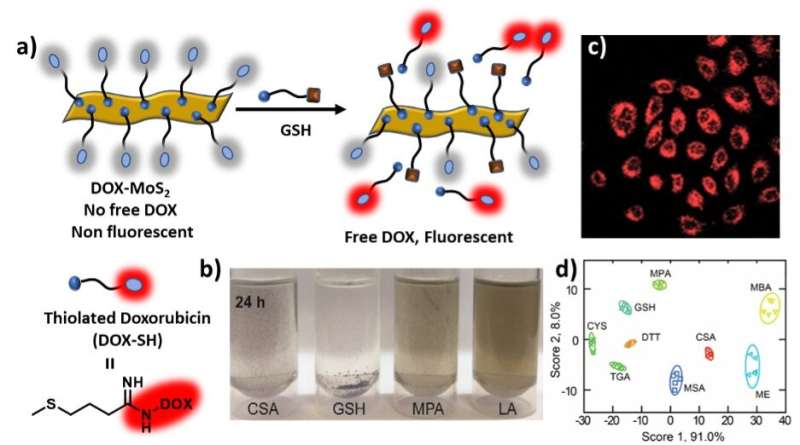
In a current examine, researchers from the Division of Natural Chemistry (OC) and Supplies Analysis Centre (MRC), Indian Institute of Science (IISc), present that floor modifications of two-dimensional molybdenum disulfide (2D-MoS2) nanosheets could make them extremely efficient for purposes like delivering medication to diseased cells.
Nanomaterials often have to be modified or personalized relying on the applying to enhance their effectivity. Usually, they’re chemically modified by means of a course of referred to as functionalization, which includes attaching ligands (small or giant molecules) to the floor of the nanomaterial.
Within the new examine, the researchers modified the floor of 2D-MoS2 nanosheets with thiol (sulfur-containing) ligands. They discovered that these thiols will be exchanged with naturally-occurring thiols in organic methods, which might permit medication connected to those nanosheets to be launched. These chemically-modified nanosheets have been additionally discovered to be secure to make use of inside residing cells.
“Our examine reveals that thiol alternate on 2D-MoS2 nanosheets is efficient, and the nanomaterial is secure within the presence of assorted biomolecules. This is a vital commentary as it’s going to make this nanomaterial extremely helpful for biomedical purposes like drug supply,” explains Mrinmoy De, Affiliate Professor on the Division of Natural Chemistry and senior writer of the examine printed in ACS Nano.
The workforce first used a fluorescent thiol referred to as boron-dipyrromethene (BOD-SH) to change the floor of the 2D-MoS2 nanosheets to be able to create a functionalized model (BOD-MoS2). Then, they examined the opportunity of thiol-to-thiol alternate on BOD-MoS2 utilizing glutathione (GSH)—a naturally occurring thiol present in abundance in most cancers cells. They discovered that GSH molecules swapped locations with BOD-SH on the floor of the nanosheet—a course of that they confirmed utilizing fluorescence methods.
When the researchers connected an anti-cancer drug named doxorubicin (DOX) to the nanosheet floor, they discovered that thiol alternate might additionally occur between GSH and DOX, permitting DOX to get dropped off on the diseased web site. As a result of the alternate occurs solely within the presence of excessive concentrations of GSH present in diseased cells, medication like DOX will be delivered particularly to most cancers cells with out affecting regular cells, which might additionally doubtlessly cut back any unwanted effects.
Earlier efforts have centered on utilizing gold nanoparticles for such biomedical purposes, in line with the researchers, however these nanoparticles are costly and have restricted effectivity attributable to their non-selectivity between mono thiols and disulfides.
“Our experiments present that 2D-MoS2 nanosheets will be an efficient substitute for gold nanoparticles, and they are going to be enormously helpful within the discipline of nanomedicine,” says Pradipta Behera, a postdoctoral analysis scholar at IISc and the primary writer of the examine. The MoS2 nanosheets have been discovered to be secure within the presence of biofluids. In addition they have a better floor space than gold nanoparticles, which implies that they are often extra environment friendly.
Transferring ahead, the workforce plans to work on bettering the soundness of the nanomaterial within the presence of assorted thiol-containing liquids and exploring different floor modification approaches to customise the nanosheets for different purposes. “This work on 2D-MoS2 nanosheets will be developed sooner or later as an alternative choice to RNA and DNA supply purposes, which will be helpful for detecting and treating infections similar to COVID-19,” provides Behera.
Extra info:
Pradipta Behera et al, Ligand Alternate on MoS2 Nanosheets: Purposes in Array-Based mostly Sensing and Drug Supply, ACS Nano (2022). DOI: 10.1021/acsnano.2c06994
Offered by
Indian Institute of Science
Quotation:
Chemically modified nanosheets for biomedical purposes (2023, March 2)
retrieved 2 March 2023
from https://phys.org/information/2023-03-chemically-nanosheets-biomedical-applications.html
This doc is topic to copyright. Aside from any truthful dealing for the aim of personal examine or analysis, no
half could also be reproduced with out the written permission. The content material is offered for info functions solely.
